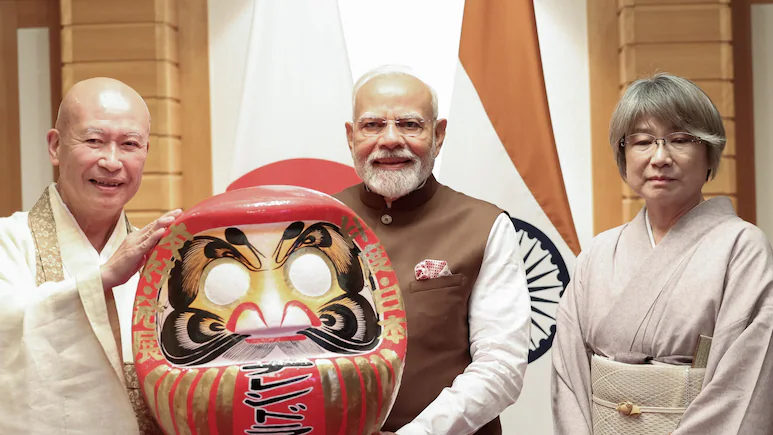Modi on two-day state visit to Japan, presented with Indian-origin Daruma doll
Strategic talks will address regional security, maritime cooperation, and collaboration under the QUAD framework alongside the United States and Australia. People-to-people exchanges, cultural ties, and cooperation in education and science are also on the agenda.

Indian Prime Minister Narendra Modi arrived in Tokyo today (August 29, 2025) on a two-day visit at the invitation of his Japanese counterpart, Shigeru Ishiba. This marks Modi’s eighth visit to Japan, where he is attending the 15th India-Japan Annual Summit.
From Metro to manufacturing, from semiconductors to start-ups, India-Japan partnership in every sector became symbol of mutual trust,” said PM Modi said addressing the India-Japan Joint Economic Forum.
.
The two Prime Ministers will hold the much-delayed 15th annual summit, and are expected to upgrade the 2008 Declaration on Security Cooperation, including defense hardware purchases, launch an “Economic Security” initiative to build resilient supply chains in a number of areas such as critical minerals and Artificial Intelligence, and increase Japan’s investment targets to around $68 billion.

At the India-Japan Summit with Premier Ishiba, the two sides will release a joint statement as well as the “2035 Vision Statement” for the future of the relationship to upgrade the 2025 Vision Statement announced by Modi and then Prime Minister Shinzo Abe a decade ago.
The meeting marks 20 years since the first annual summit in 2005 when then Japanese Prime Minister Junichiro Koizumi met former Indian PM Manmohan Singh in Delhi.
Strategic talks will also address regional security, maritime cooperation, and collaboration under the QUAD framework alongside the United States and Australia. People-to-people exchanges, cultural ties, and cooperation in education and science are also on the agenda.
As part of the customary exchange, Prime Minister Modi was gifted a Daruma doll, a traditional Japanese symbol of perseverance and good fortune. The doll’s design reflects resilience and determination, aligning with the Japanese proverb “nanakorobi yaoki” — “fall down seven times, get up eight.”
The Daruma doll traces its origins back to Bodhidharma, a monk from Kanchipuram in Tamil Nadu, born in 440 AD. Bodhidharma travelled to China in the 5th–6th century to spread Buddhist teachings, eventually founding what became Chan Buddhism. Over time, Chan Buddhism spread to Japan and evolved into Zen Buddhism.
According to legend, Bodhidharma meditated for nine years, which led to the loss of use in his limbs. This story inspired the design of the Daruma doll: round, hollow, weighted at the bottom, and without arms or legs.
In Japanese tradition, when a person sets a goal or makes a wish, they paint one eye of the Daruma doll. Once the goal is achieved, they paint the other eye to complete it. The dolls are kept in homes, shops, and temples as reminders of determination and as lucky charms.
Daruma dolls remain an integral part of Japanese life and culture. They are widely used during the New Year to set resolutions and goals and are cherished in homes, shops, and temples.
Most dolls are produced in Takasaki, Gunma Prefecture, using traditional papier-mâché methods passed down for over 200 years.
At the end of each year, old Daruma dolls are brought back to temples for the Daruma Kuyo ceremony, where they are burned in bonfires by monks to honor past efforts and inspire fresh aspirations. The doll has also become a familiar figure in Japanese pop culture, appearing in games, anime, and festivals.
Follow The Times Kuwait on X, Instagram and Facebook for the latest news updates













